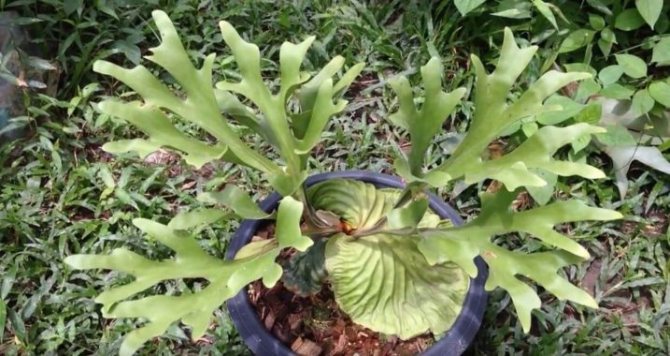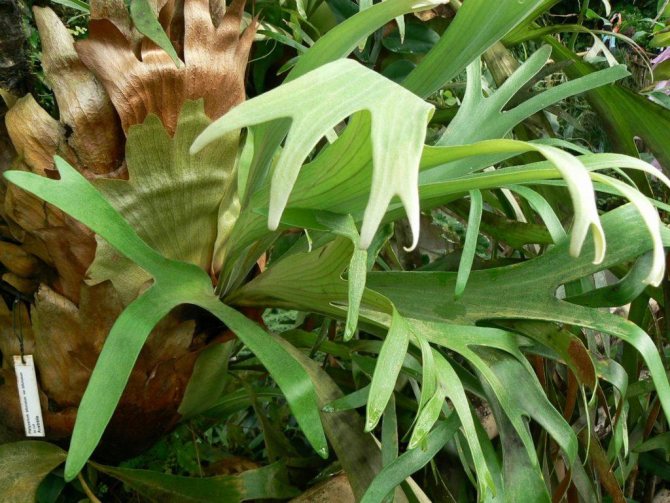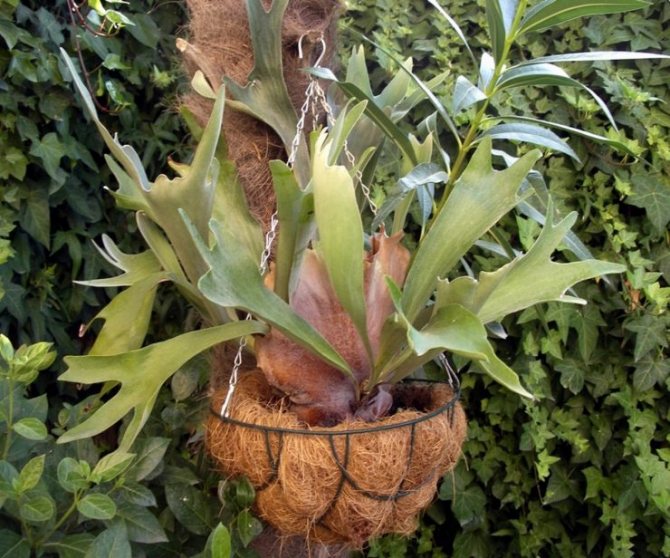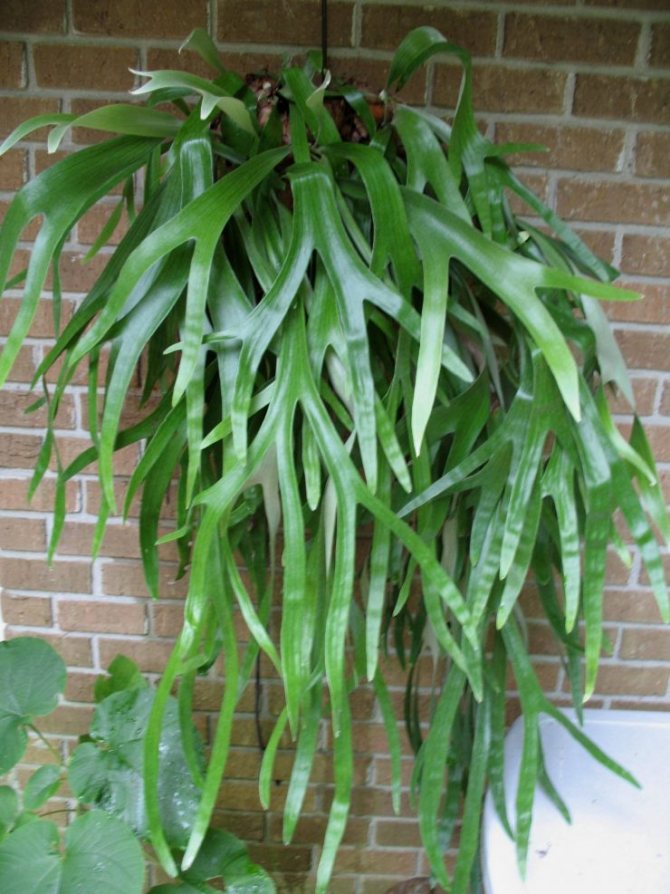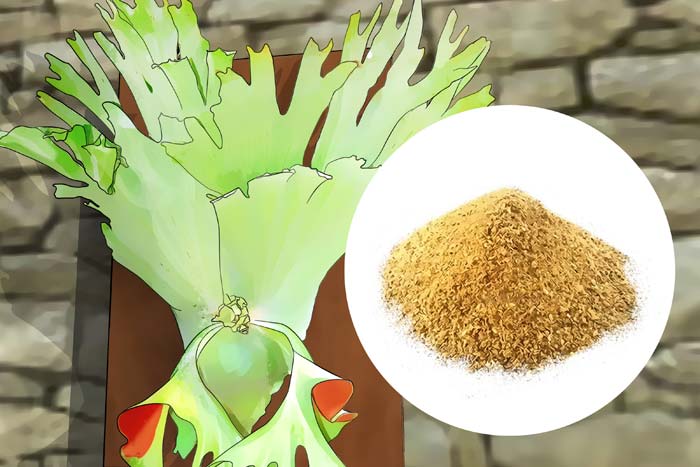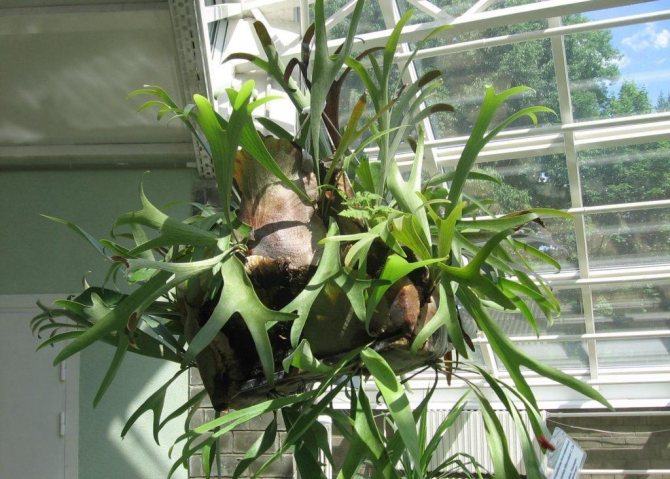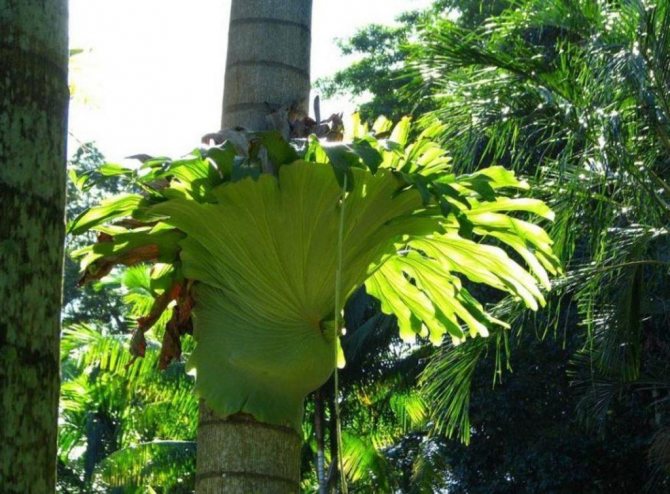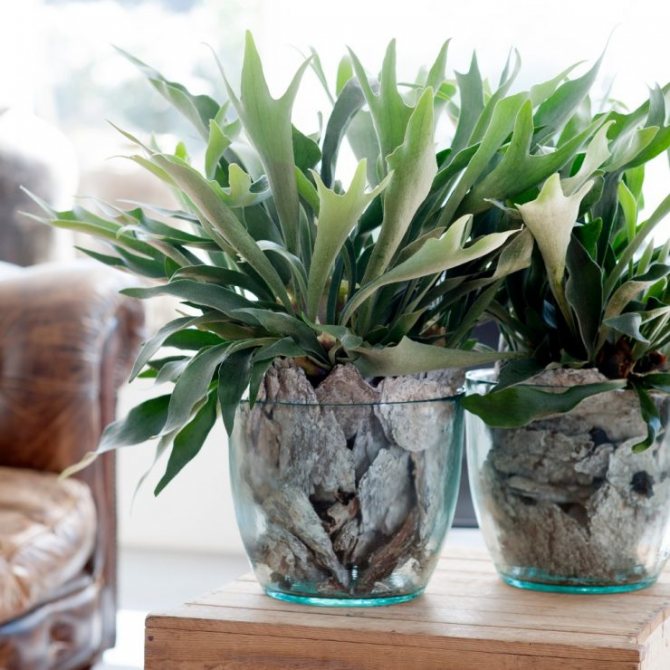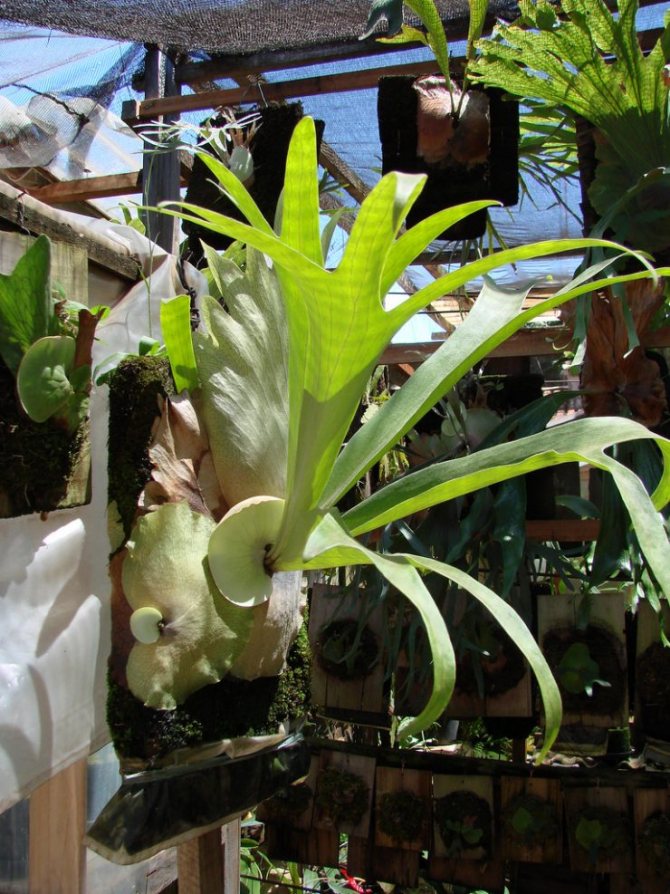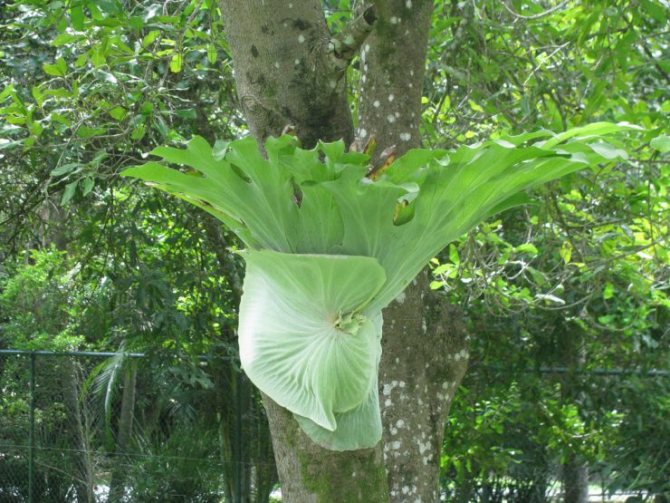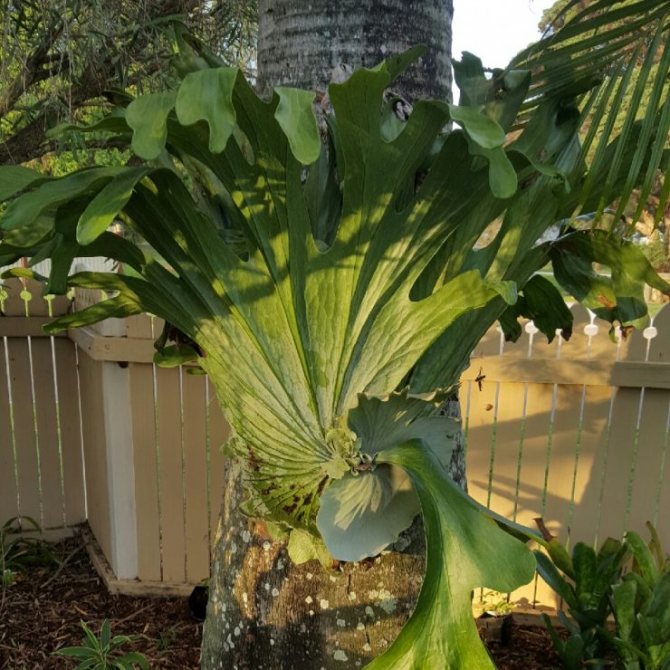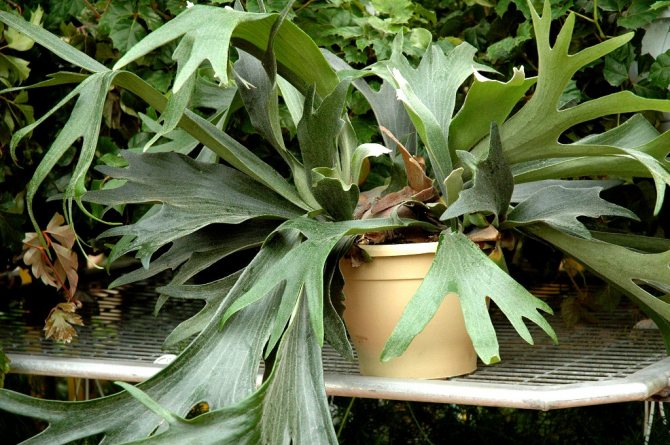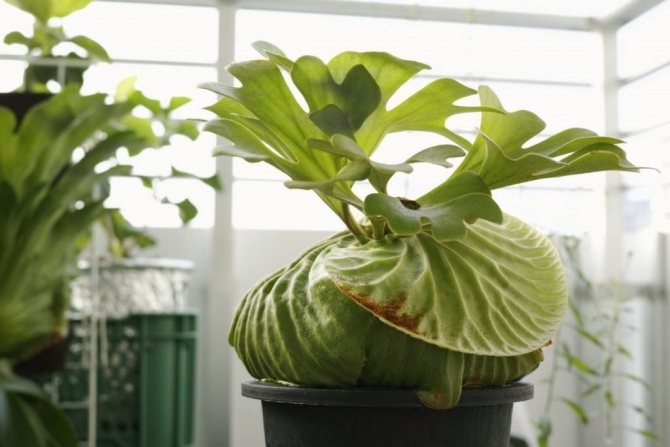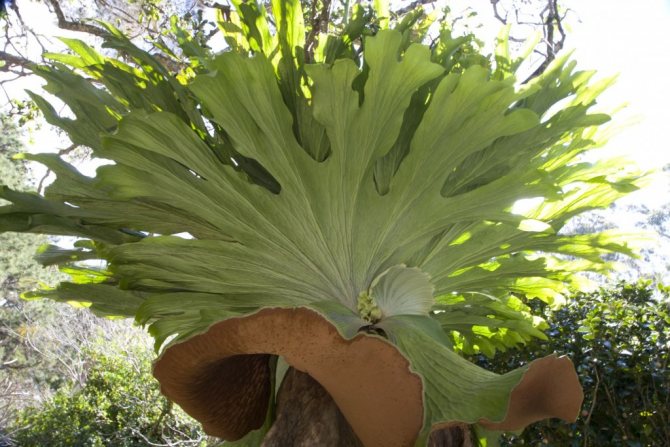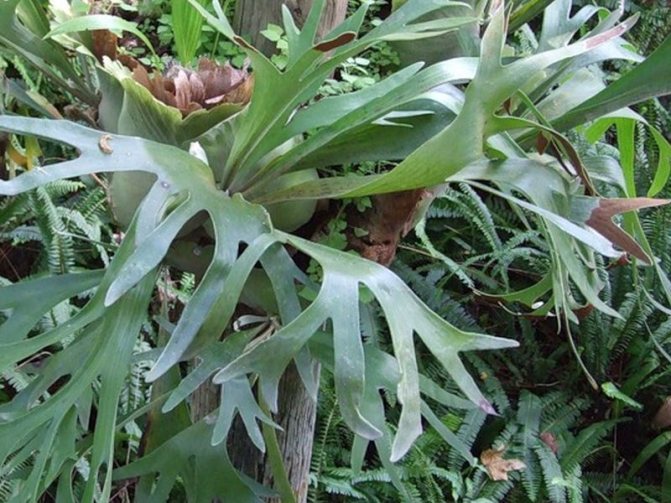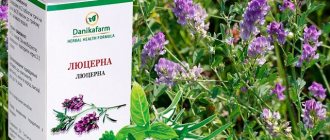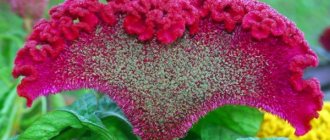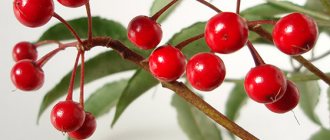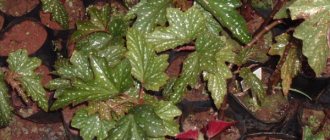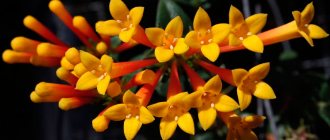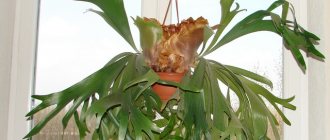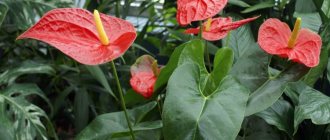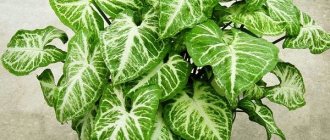Types of platycerium
In the natural environment, there are 18 species of this plant, but at home only such varieties of Platycerium are grown:
- Angolan. Differs in solid spore-bearing leaves of a triangular shape, up to 40 cm wide. They are expanded to the upper edge, which has orange notches and pubescence.
- The Platitzerium is large. This large plant is found in the forests of Asia and Australia. The fern has leaves dissected at the ends, which reach up to 60 cm in width. Spore-bearing fronds with a wedge-shaped shape grow up to 2 meters in length.
- Hill's Platycerium. Outwardly, it resembles a large Platizerium, but with more fragile and graceful leaves. Its straight fronds are not deeply dissected, and individual segments are sharpened at the tips.
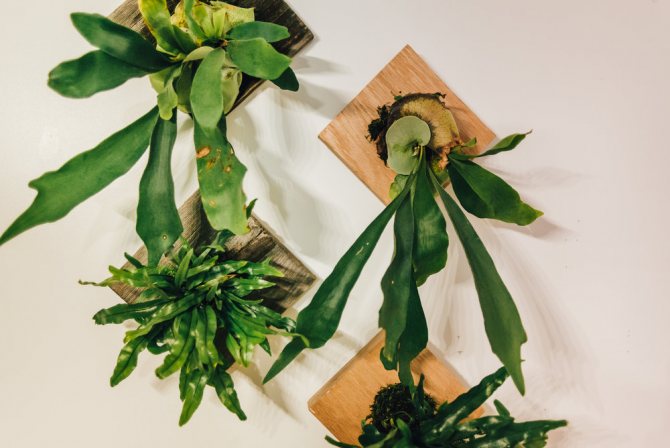
All these species deserve attention, but nevertheless the most popular is the platycerium variety "antlers". Details about it are described below.
Types and description of the antler flower
Until recently, coral ferns were rare in the homes of florists. Now they are becoming more and more popular and the ranks of their fans are growing every day.
The antler flower (the second name is Platycerium bifurcatum) prefers the tropical regions of South America, Africa, Australia, Southeast Asia and New Guinea. The genus Platycerium includes about 18 species, but only a few of them can be grown as indoor plants. Some representatives of this genus grow as epiphytic (on trees), others as lithophytes (on rocks). The most decorative types:
- Platycerium alcicorne
- P. angolense (P. Angolan);
- P. coronarium (P. coronary);
- P. grande (P. large);
- Ridleyi (P. Ridley).
Among the highly decorative fern species, a special place is occupied by the Deer-horned Platycerium. Under natural conditions, it grows, attaching itself to the tree with the help of a weakly expressed root system. "Deer antlers" is not a parasite and does not harm the tree on which it lives. The plant receives water and nutrients through the leaves. In ferns, the leaves are called fronds, and in Platitserium, there are two types of them:
- Spore-bearing - the main "decoration", giving the plant similarity with deer antlers. They can grow up to 60-80 cm, dividing in the course of growth into reed lobes 2-3 times. Fern spores are located under the lower surface of the leathery leaf plate in a rusty scattering. Newbie growers may mistake brownish spore spots for a disease affecting their handsome deer antlers.
- Sterile. As a rule, they are round in shape, form a kind of rosette at the base of the plant, which helps to better attach to the surface of the tree. The fronds are initially green and juicy, but eventually lose moisture and turn brown and thin like parchment paper. In addition to assisting in attachment, this type of leaf helps nourish the entire antler flower as it is organic matter accumulates under them.
Attention! The brown color of the fern leaf plates does not mean that the plant is dying or sick, and in no case should they be removed!
Description
The Platycerium, or antler fern, belongs to the centipede family. This large epiphytic plant is found in the tropical rainforests of Australia.It is distinguished by the presence of two types of wai: sterile and spore-bearing. The first, a little like cabbage leaves, are round and wide, tightly wrapped around the trunk of the tree to which the plant clings. They form a cap up to 1 meter in diameter, covering the root system. Over time, the remains of fallen leaves, insect corpses and other debris accumulate in it, which serves as a kind of nutrient substrate for the fern.


Large spore-bearing fronds emerge from the center of the cap, reaching a length of up to two meters. They are distinguished by a special curved shape, in fact, for which the plant received the second name "deer antlers". It will not work to see how the platycerium blooms. This fern does not produce buds and reproduces, like all representatives of its species, by spores.
Features of the platycerium
Belongs to perennial plants and to the fern class. Not picky about leaving. The plant is interesting in that it has two types of leaves:
- spore-bearing - in appearance they resemble deer antlers;
- sterile - similar to a nutshell, serve as food gatherers. They get insects, leaves, etc. After a certain period of time, such food decays and provides food for the fern. Therefore, in no case should you remove dead leaves - this is an important source of nutrition for the root system.
Home care
Platizerium is a plant that can hardly be called unpretentious. And to grow it at home, it will take a lot of effort and recreate an environment close to natural. Fern care consists of the following agrotechnical measures:
- regular watering;
- periodic feeding;
- transfer;
- prevention of diseases and pests.
In addition, in order for the plant to feel comfortable, it needs to create a certain humidity in the air and maintain optimal temperature and lighting in the room. More details about these growing rules are described below.
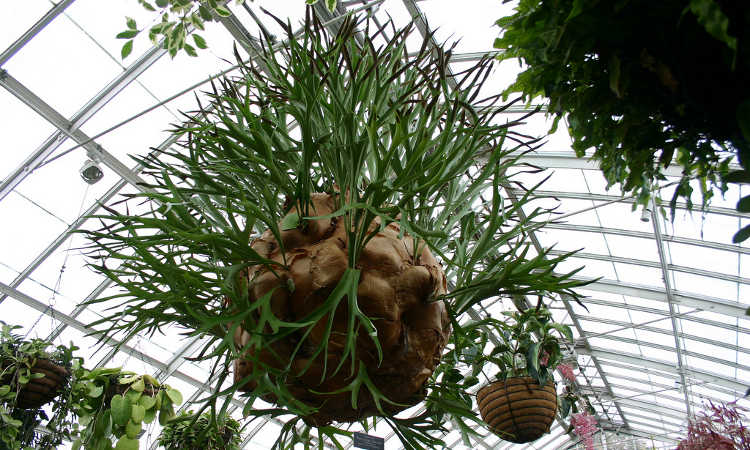

Planting and transplanting
The soil should be light with the obligatory presence of moss, peat, leaf humus and pieces of rotten branches. It is difficult to prepare a suitable soil at home. Orchid potting mix, available from the store, works well.
The plant has a small root system, so transplanting is required as the volume of the pot is filled. On average, the bush is transplanted every two years. A favorable time for transplantation comes in late February - early March. A wide and low pot is the best option.
In order to prevent root rotting, expanded clay is poured into the bottom of the pot... The roots of the plant should not be deeply deepened into the soil, but also should not be placed close to the surface of the earth.
Lighting
Platycerium "deer antlers" is a light-loving plant, but direct sunlight is contraindicated for it, because from them the leaves of the culture get severe burns and wither. Therefore, choose the east or west side of the room to grow your fern. The plant will take root in the north, but here it will need additional lighting with a phytolamp.
If you plan to grow a fern exclusively under artificial light, then keep in mind that the illumination level must reach at least 4300 lux. And the length of the day should be at least 10 hours a day.
Creation of conditions for the growth of platycerium indoors
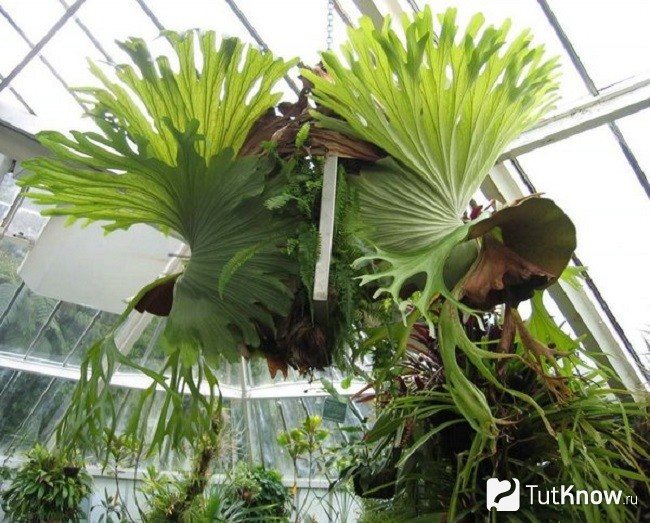

Lighting
In order for the plant to stay in good condition, it should not be exposed to scorching sunlight, but at the same time it likes sufficient lighting, although it may be in partial shade. Windows that face the west or east side of the world are quite suitable for installing a pot with platycerium on their windowsills. For example, if the bathroom has a large window, then this place will be good.The fern does not tolerate drafts or harsh cold air at all, but loves frequent ventilation. The plant is very badly affected by dust and smoke in the room. Of course, the plant will not die in full shade on the windows of the northern exposure, but its growth will slow down significantly, or it will stop growing altogether.
Platizerium signals the quality of illumination by the shape of its leaf plates. If they are upright, powerful enough and short, this means that the plant has enough light or it is bright enough. In another case (with a lack of illumination), the leaf plates begin to lengthen and change their shade to the dark green side, bending over and hanging from the pot or pots. Also, good lighting becomes a guarantee that the Platycerium will not be affected by various diseases and attack by pests.
It is characteristic that different species of this fern can be kept under different lighting conditions. If the leaf plates differ in length, then the plant is quite light-loving, short and powerful leaves speak of unpretentiousness to the luminous flux.
Platycerium content temperature
In order for the fern to develop well, it is best to maintain temperature indicators within 20 degrees. As soon as they begin to exceed the mark of 24 degrees (there are species that survive at 35-38 degrees), it is necessary to significantly increase the humidity in the room in which the platycerium is located. With the arrival of the autumn-winter period, a decrease in temperature to 15-17 degrees is allowed. This fern is very fond of warm rooms, and as for the large Platycerium grande species, it can withstand temperatures only up to 18 degrees, the bifurcated fern variety (Platycerium bifurcatum) calmly tolerates zero temperatures.
Air humidity
The characteristics of the moisture content in the air should be close to 50-80%. For this plant, spraying is very undesirable and they are used in extreme cases, the spray jet must be very finely dispersed. This is characterized by the fact that the leaf plates have a slight pubescence and drops of moisture simply roll off the hairs. And with such an action, the increase in humidity lasts for a very short period and can be taken as a temporary measure. Platiterium is very sensitive to the dry air of city apartments, so it is better not to install it with central heating batteries. It is recommended to place the plant above a pallet with moistened sphagnum moss or in a pallet on fine expanded clay or pebbles, where water will be poured.
Humidity
The antler fern lives in humid tropical forests, therefore, the dry conditions of an ordinary apartment are not suitable for it. And in order to recreate the natural environment, it is advisable to put a special humidifier next to the pot. If you do not have such a device, then at least install a flowerpot with a plant on a pallet filled with wet expanded clay or pebbles. But make sure that the water does not reach the drainage hole, otherwise the fern roots "suffocate". Better yet, hang the plant over the aquarium.
Also, do not forget to regularly spray the platycerium leaves with a spray bottle. But use warm and always filtered water for this. Otherwise, the leaf scales will become clogged with the smallest particles, which will negatively affect the health of the fern.
Keep in mind that the surface of the plant is covered with velvety hairs that trap moisture from the air. And so as not to damage them, never wipe the fern leaves with a damp cloth. And if their surface is covered with dust, then remove the dirt with abundant spraying. Or use a soft bristled brush.


Fern platiterium or flat-horned (with photo)
The platiterium fern is so popular that it has been given many "popular" names. Plokskorog is one of them, the most famous and popular. Look at the photo, which shows the options for using it in interior decoration:
Rod Platitzerium
–
Platycerium.
Family Polypodiaceae.
Number of species:
17.
Natural climatic conditions:
tropics of Australia.
Platizerium
(
platitserium
) - flathorn or antler - this is an epiphytic exotic plant - a fern of the centipede family with spectacular, leathery, grayish-green spore-bearing or sterile waves, divided into lobes, growing up to 90 cm and very similar to the antlers of an elk or deer. Platizerium grows up to 1.2 m, does not bloom.
Ferns of the genus Platiterium grow in the tropics of Asia, Australia, the islands of the Indian Ocean, the Malay Archipelago, the Philippines, Africa and the island of Madagascar. Platitzeriums are the largest, most beautiful and most unusual of the ferns. The name of the genus comes from the Greek words platys - flat and keras - horn: in the form of fertile wai, reminiscent of deer or elk antlers. Epiphytic ferns from tropical forests. In indoor floriculture, only two species are cultivated - both of them are epiphytes and grow well indoors. Many garden forms are available.
Views:
in a room culture grown Platycerium large and p. double-forked.
Description: This epiphytic fern growing on pieces of bark or in hanging baskets has an appearance so unusual for ferns that it stands out sharply against their general background. Its fronds resemble spreading deer antlers (hence the name). Platycerium has two types of fronds: spore-bearing - in the form of deer antlers, and others - sterile, more like the shell of a huge nut and supporting the plant on branches and trunks of trees. In addition, barren fronds are food gatherers for ferns. Leaves, moss, dead insects, etc. fall into them, as in a trap. Over time, all this decays and forms the soil from which this spectacular and unusual fern feeds.
Landing rules
It is advisable to grow deer antlers fern on blocks, in plastic pots with slots, hanging baskets or wide clay flowerpots. When planting this plant, keep in mind that over time, its sterile fronds will completely stick around the planting container, which will block access to the roots. Therefore, choose larger planters to provide sufficient space for the plant to develop and grow.
If you plan to plant a fern in a pot or hanging basket, then prepare slightly acidic loose soil, consisting of small pieces of bark, sphagnum moss and coarse peat. Be sure to add some charcoal to this mixture to prevent rot development. If you do not want to fool around with the components, then purchase a ready-made substrate for the fern intended for orchids.
If you plan to grow the plant on blocks, then create a thick "pillow" of coarse peat and sphagnum moss around the root system. Then tie it to a vertical block, such as a large piece of pine bark or a plastic trellis. As it grows, the lower leaves will grip the structure tightly and the plant will be securely anchored.


Features of the care of the Platyzerium
The flower is quite whimsical. Home care requires adherence to the rules.
Location, lighting
The plant feels comfortable on the west or east side, in bright but diffused light. The longer the branches, the worse it tolerates shade. Prolonged stay in a shaded area leads to stuntedness, darkening of color.
Temperature
In summer, + 20 ... + 25 ° С is enough, intense heat lowers the level of humidity. In winter, it may drop to + 14 ... + 17 ° С. Some varieties also tolerate lower temperatures.
Humidity
A tropical inhabitant is accustomed to dampness (the optimal figure is 80%).Spray on top as often as possible, be sure to fine spray.
If there is an aquarium in the room, or a humidifier, hang next to it. It is undesirable to place it close to heating devices and in strong drafts.
Watering
Transplant, soil, growing pots
For planting, you need a slightly acidic soil (pH 5.5-6), a ready-made substrate for orchids is suitable. They make a mixture of the components on their own:
- deciduous humus 20%;
- coarse sand 20%;
- natural high-moor peat 40%;
- pine bark mulch 10%;
- dry moss 10%.
And also add charcoal powder, 2% of the filler volume.
Transplanted after two years. The roots of the antler are underdeveloped, a flowerpot of shallow depth is needed. A water-permeable layer is placed below. Dying off parts are not removed - they remain an element of the nutrition structure.
When diluted with a block, the roots are placed in a raw sphagnum wrapper, fixing it with fishing line or thin wire. Whenever possible, add nutrients under wide flatteners.
Hanging pots made of kokovita or wooden planks in a carved frame are used as a support. Such a composition looks like a creation of an artist, gives an exotic flavor to the interior of the house.
Reproduction of the platycerium
The reproductive period begins after 7 years. Ripe spores are scattered over a shallow sphagnum ball. Before starting, it should be sterilized with boiling water and wait until it cools down.
The seed container is covered with a glass lid until shoots appear. Nursing requires a warm, shaded area with stable moisture.
When transplanting, neat division into containers is allowed.
Children (young shoots) are planted on pebbles with damp moss. Kept under the film for four days to get stronger, cultivated in a standard way.
Despite the capriciousness, the flathorse perfectly filters harmful impurities, improving the microclimate of the room.
The platycerium fern can be rarely seen in our houses and apartments. Most likely because it has a peculiar appearance of it, and besides, caring for it has many subtleties.
This plant belongs to the millipede family. Its second name is “deer antlers” fern, because of the special appearance of the flower. In its natural environment, this species grows in the tropics of Australia. It is cultivated as a houseplant, but rather rarely.
The flower has one generic feature - it has two types of leaves, which differ in structure: spore-bearing - large, showy (resembling horns), and sterile - whole (located at the very base).
Ferns of this type are most often used for hanging landscaping, although they have nothing to do with ampelous plants.
Platizerium in the photo
Watering
Platizerium "antlers" is a moisture-loving plant that needs regular watering. Fern does not tolerate drying out of the soil, but stagnation of moisture at the roots is contraindicated for it. Therefore, watering should be treated responsibly. Moisten the soil as soon as the top layer dries. If sterile leaves have blocked access to the roots and you cannot assess the condition of the substrate, then it is better to skip watering and irrigate when the frond plants are slightly wilted and wilted.
In any case, moisten the plant only with soft, filtered and settled water at room temperature. In addition, experienced flower growers recommend using the bottom watering method, when a pot or block is dipped in a container of water and left for 20-30 minutes. So, you give the fern the opportunity to nourish the amount of moisture that it needs. After watering, do not rush to put the flowerpot in its usual place, but wait a few minutes for the excess liquid to escape.
Platycerium two-forked
Platycerium two-forked
(Platycerium bifurcatum)
, a synonym for Platycerium alcicorne, is relatively easy to grow indoors. Sterile fronds are round, 12-20 cm in diameter, convex, lobular along the edges.
Spore-bearing fronds reach a length of 50-90 cm, tapered at the base, widened in the upper part like a fan, dissected into hanging lobes 3-4 cm wide. Sporangia along the entire upper part of the lobes are yellow-brown.
Top dressing
The deer antler fern responds well to fertilizing. Therefore, it is advisable to fertilize the plant at least once a month. Carry out this activity after watering and use specialized preparations for ferns as top dressing. But give Platycerium only half the dose that is indicated on the package. In addition, experienced flower growers recommend using banana peels or boiled tea leaves to feed the plant, which should be placed under the dome formed by sterile leaves.
Soil and fertilizing
The substrate should consist of coarse peat, moss and leafy soil. If the plant does not rest on a piece of bark, then it is recommended to add bark of trees taken from the forest to the soil. You can also purchase a ready-made earthen mixture for orchids or ferns. You can also grow Platiterium on pieces of bark or stumps. It is necessary to feed during the period of active growth, 2 times a month, with a semi-concentrated fertilizer for any decorative leafy plants. In the autumn and winter seasons, Platiterium is not fertilized, as an excess of minerals can lead to disease.
Transfer
This event can only be held for young plants. But it is strongly not recommended to transplant adult specimens, because as they grow, their sterile leaves tightly cover the pot, which is why they can be easily damaged during the procedure. In addition, the event affects the decorative appearance of the fern. After all, even if you manage to carefully separate the leaves from the flowerpot, then after transplanting they will no longer create a membrane dome, pressing against the surface. Therefore, Platycerium is transplanted only in extreme cases.
Nevertheless, it is advisable to change the bottom layer of soil by getting close to it from the bottom of the flowerpot. To do this, even during planting, you need to make several slots in the bottom of the pot or basket.
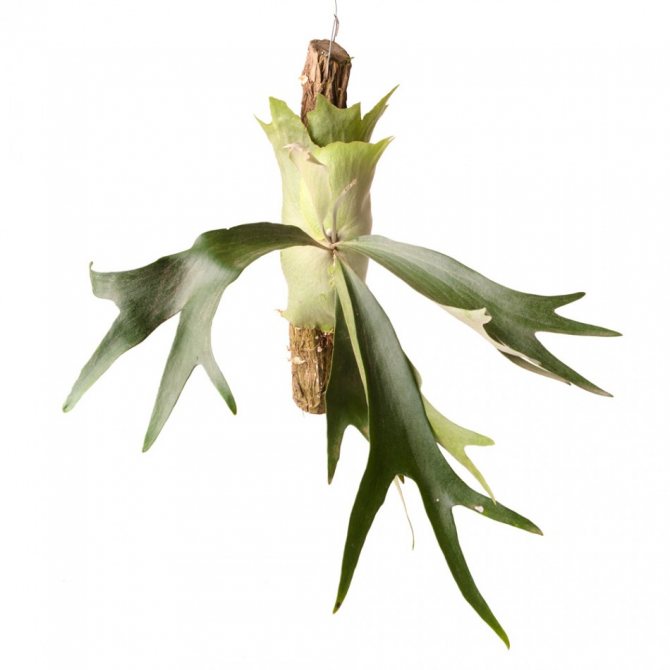

Views
Bifurcatum
The Bifurkatum variety is characterized by two types of leaves: spore-bearing and sterile. The spore-bearing leaves seem to have a layer of dust and inexperienced growers even try to cut or wash it, but this is not necessary. Small fibers protect the leaf from sunburn and prevent intense evaporation of moisture.
Large
Sterile leaves are wide and can reach up to 1 meter in length, deeply forked (not drying up for a long time), hanging from the middle of the leaf. Highly decorative look. Grown in warm greenhouses and rooms.
How to propagate the antlers plant
It is almost impossible to propagate this capricious plant. At home, even in the presence of a warm winter garden, the Platitzerium rarely releases spores. Nevertheless, some growers manage to get root buds, from which rosettes of leaves are then formed. These children are later used for reproduction, planting them in separate pots.
If your fern has released a similar bud, then do not rush to separate it, but wait until it gives roots. And only then transplant it into a separate pot. At first, keep the baby under a polyethylene hood to create a humid environment.
If you managed to get spores, then sow them into moist soil consisting of peat and sphagnum. Be sure to disinfect the substrate before doing this. To do this, hold it over steam or bake it in the oven. After sowing, cover the container with glass or plastic and place in a warm place with diffused lighting. Ventilate the planting regularly and spray the soil with warm water from a spray bottle.
Spores can germinate from two to six weeks. Keep young seedlings further under glass and do not forget to moisturize them. When the plants are strong enough, transplant them into individual containers.
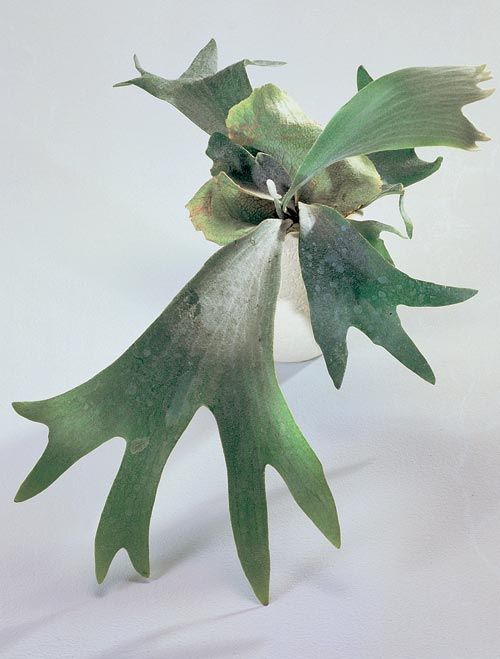

Reproduction
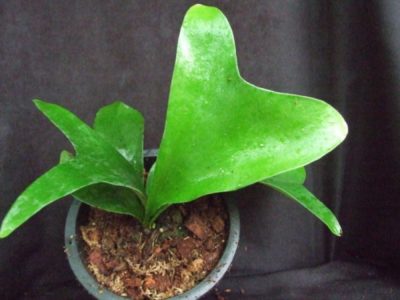

This is a rather complicated process. In rare cases, the plant may develop shoots.
But if such a phenomenon occurs, then it is necessary to wait for the formation of their root system and plant them in separate pots.
You can try to divide the plant and plant it in different containers.
But in this case, there is a huge risk of losing all plants.
Disputes
Reproduction by spores is even more difficult. Even the most experienced growers rarely succeed in such a thing. Spore-bearing leaf plates begin to fulfill their main task very late, it is necessary that the bush be at least 5 years old.
When using this type of reproduction, you should adhere to the following algorithm of actions:
- spores must be separated from the sheet and dried in a paper envelope;
- put a brick in a plastic container;
- lay out moistened peat on the surface of the stone;
- pour water into a container;
- immerse spores in peat and cover with a plastic bag in order to create a greenhouse effect;
- the container is placed in a dark place;
- add water if necessary;
After about two months, green moss should form, followed by leaves. Planting should only be done when the plants have reached a size of more than 5 cm.
Diseases and pests
Deer-horned Platycerium is ill only with improper care. In most cases, growers are faced with the following problems:
- Fern fronds turn pale and sluggish. This is how the plant signals an excess of light. Move the pot to a shaded area and the fern will recover. In addition, the leaves can turn pale due to a lack of nutrients. In this case, feed the plant.
- Dark dry spots appeared on the Vayays. This damage is caused by burns. Do not forget that Platizerium does not tolerate direct sunlight.
- The edges of the wai began to dry out. A similar phenomenon occurs when the fern is grown indoors with too dry air. Place a humidifier or container of water near the plant and remember to regularly spray the leaves with warm water from a spray bottle.
Of the pests, the fern is annoyed by scale insects, spider mites and thrips. At the first signs of the appearance of parasites, treat the plant with a systemic insecticide, for example, "Aktelik" or "Fitoverm". And if your pet was attacked by scabbards, then in addition to treatment with drugs, you will have to remove the pests manually. To do this, use a cotton swab dipped in an alcohol solution.
Fern platycerium: care and features of nursing
This fern species is quite capricious. The main difficulty of care is maintaining the necessary air humidity in the room in which your pet lives.
- The northern side is considered the most favorable for cultivation. It does not matter to Platitzerium whether it will be light or dark, it is shade-tolerant.
- Direct sunlight should not hit the leaves. Often, a flower does not require natural light at all, it can grow in full artificial light. Although there is a completely opposite opinion that with a lack of light, the fern does not form spores.
- It is unpretentious to the climate, but it is better not to allow sudden temperature jumps, to make sure that the thermometer does not drop below 13 degrees. In summer, with abundant watering, it even tolerates a heat of 37 degrees.
- A fern can be cultivated on bark or a piece of wood. The growing substrate is made up of a mixture of peat, humus, pieces of bark, chopped moss. If you decide to buy ready-made soil, buy a specialized "For ferns".
- The plant is very hygrophilous, requires abundant watering and does not tolerate the drying out of an earthen coma.
- Spraying procedure is mandatory.But it is strictly forbidden to wash the leaves and even just wipe them with a damp cloth.
- It is advisable to fertilize during the active growing season. We alternate mineral fertilizers and organic ones.
- An annual transplant with the removal of decayed roots is desirable.
- It reproduces in two ways:
- Division of rhizomes.
Disputes.
For sowing spores, it is necessary to use shallow containers like Petri dishes (pictured)
Possible growing errors: table
| Manifestation | Cause and characteristics of the error | Correction method |
| Brown spots on fronds | Sunburn, wrong growing area | The plant should be rearranged to a less illuminated place. |
| Whitish bloom on fronds | Lack or excess of essential nutrients, improper or untimely feeding | Feed the plant correctly |
| Drying the tips | Improper watering or lack of watering at the right time | Compliance with the watering schedule. Monitoring the condition of the soil, especially its beginning drying out. |
| Withering | Excessive watering, root decay begins | Stop flooding the plant and check for drainage |
Green exotic fern horns
As soon as the platyceria are not called: both flathorns and deer antlers. And all the nicknames more than colorfully outline the main pride two-forked platycerium (platycerium bifurcatum) and platycerium large (platycerium grande) - horn-like leaves. These are two of the most common indoor fern species. But the extravagance of Platyceria is not limited to leaves alone.
Platycerium double-forked - unique epiphytic ferns. They develop on the bark or trunks of trees like epiphytic orchids, and this form of growth determines the specifics of their cultivation.
And here platitzerium large develops in a slightly different way: it forms original nests of green leaves, the wide and solid lower part of which passes into horn-like endings characteristic of all Platyceria. The gradual blooming of the leaves, as if rolled into a tube, the contrast between the young leaves with a whole edge and carved "deer horns" make this Platitzerium even more original.
The exotic fern looks like antiquity revived. And this is not surprising. This is far from a modest plant, in which in nature the leaves reach 1 m in length, and in indoor culture they are limited to 20-40 cm (only in greenhouses flathorns are larger).
The leaves of Platyceria are no less spore-bearing than the fronds of other ferns. Light green leaves with a beautiful white pubescence on the surface grow in the form of bizarre and dissected plates, the shape of which almost perfectly repeats the contours of deer antlers.
But if you take a closer look, it becomes obvious that this fern, in addition to the "ceremonial" leaves from the buds, also produces much less noticeable, but more important in the development of the plant, protective scaly leaves that develop on the bed and completely dry out, forming a kind of protective layer for the roots platizerium. It is thanks to the scaly leaves that the plant gains the ability to accumulate nutrients and water.
The growth form of platyceria also determines how best to present them in the interior:
- platycerium two-forked looks more advantageous in ampelous form, hanging baskets, unusual hanging structures and containers;
- platitzerium large it is also good in large containers, in containers of unusual shape, which will emphasize the exotic status of the fern itself.
Platizeriums cannot be called easy-to-grow plants. These are capricious, or rather demanding on the growing conditions of crops, which need specific care and strict control over the indicators of temperature and humidity.It is better to take up the cultivation of the flathorse for flower growers who have experience in caring for exotics with specific requirements. The most difficult thing in growing a platycerium is maintaining stable conditions, constant characteristics of the environment. That is why Platyceria are recommended to be grown in winter gardens and greenhouses, terrariums. But since they do not need to create any extreme temperatures, with regular care, these rare ferns can be grown in normal indoor conditions.


Platycerium grande
Growing
In indoor floriculture
most often bred deer-horned Platycerium, or double-forked (Pl. bifurcatum). It can also be grown in traditional pot culture, especially young plants. But really impressive and, importantly, naturally, the fern will look in a hanging planter or basket. And even better in a block culture on a piece of a tree trunk or a piece of bark, although this method is laborious and complicated.
In any case, it should be remembered that the root system of the fern is superficial and underdeveloped, therefore, the planting capacity is selected shallow, with an obligatory drainage layer at the bottom. Do not get carried away with spraying the leaves. Moisture droplets should not linger on them for a long time. And wiping should be abandoned altogether.
Pests and diseases of flathorns
The greatest danger to this plant is the scale insects. It is very difficult to deal with them, but it is possible. To clean the plant, you cannot combine regular washing of the leaves with a sponge and soapy water and subsequent treatments with insecticides. Indeed, in flathorns, pubescence on the leaves is an important protective tool and it is absolutely impossible to wipe them. Therefore, the fight against harmful insects should be limited only to processing with special preparations.
Occasionally mealybugs are found on flathorns. You should fight him according to the same principles as with the scabbard.
If you find traces of pests, be prepared for the fact that the treatment will be long and ruin the plant for many years. Any, even the safest insecticides will leave marks and burns on the leaves, and the flathorn will have to spend a lot of time to restore its attractiveness.
Platiterium large
Distributed in Australia and South America. It is a large bushy plant up to 2 meters in diameter.
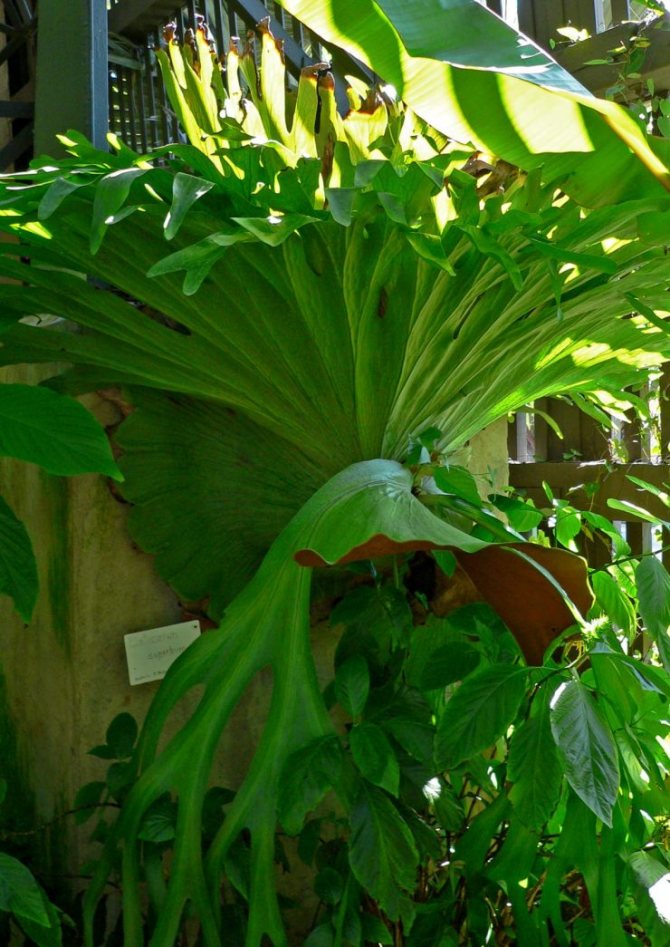

Reproduction methods


Offspring
Most often, Platycerium is propagated by grown offspring, which must have at least three leaf plates. The separated offspring must necessarily have a few roots and a bud; they are planted in a pot with a loose substrate.
Controversy
The spores of such a fern mature for a very long time, which greatly complicates their reproduction. Collect spores from bushes that are over 5 years old and sow them in a bowl filled with a moistened sterilized sphagnum / peat mixture. Cover the bowl with foil and put it on the windowsill, while protecting the crops from direct sunlight. Ventilate and moisten the substrate regularly from the sprayer. The first seedlings will appear after 2–6 weeks, until they grow up and get stronger, the shelter is not removed from the container.
1. Seven Secrets of Success:
| 1. Growing temperature: Platizerium can be grown throughout the year at normal room temperatures ranging from 18 to 24 degrees Celsius. |
| 2. Lighting: well-lit location with no direct sun access. |
| 3. Watering and humidity: a well-moistened substrate during the growing season, in winter in accordance with the air temperature in the room - the substrate is dried a few centimeters deep between waterings. Air humidity is high. |
| 4. Pruning: sanitary pruning - removal of old dying wai at any time of the year, as needed. |
| 5. Priming: nutrient substrate with a high organic content, with a neutral or slightly acidic pH, the soil should have a loose structure. |
| 6. Top dressing: during the entire growing season - mineral fertilizers or organic matter every month. Foliar dressing can be used. |
| 7. Reproduction: by division during transplantation, much less often by sowing spores in the spring. |
Botanical name: Platycerium.
Fern Platycerium - family... Polypodiae or millipede.
Origin... Africa, Asia, Australia.
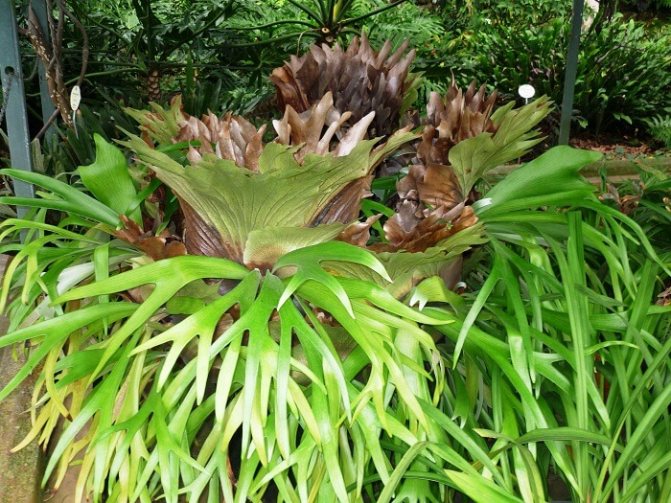

Description... The genus Platiterium or "antlers" includes about 15 species of evergreen, epiphytic ferns. The rhizomes are short, creeping, with thin, threadlike roots. The fronds are large - from 60 cm to 1.5 m, green, drooping, finger-dissected, very reminiscent of deer antlers. The few sterile leaves are round, with distinct veins, fan-like, located close to the tree on which the fern grows, they are intended to collect nutrients, turn brown with age. In nature, Platizerium grows on tree trunks, and very high.
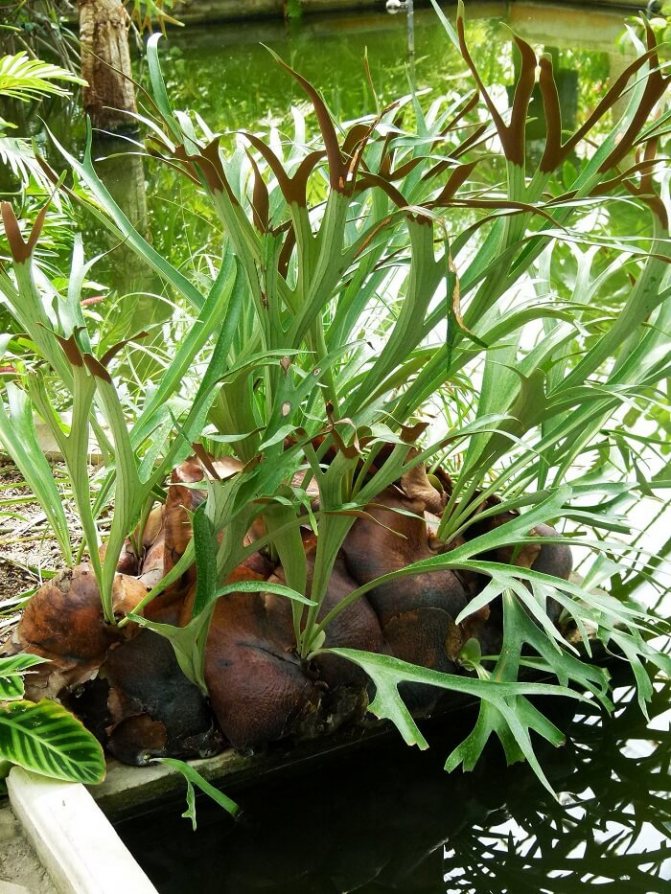

Height... Platizerium plant can reach a height of 40 - 80 cm.
Varieties


Platiterium contains a large number of species, about 15 pieces.
All these species come from India or Africa, as well as from those regions that are characterized by a warm and mild climate. Most often, among all species, two-forked platycerium are grown. It is a favorite type of platycerium among flower growers, whose homeland is Australia. Leaves reach about 10 cm in length, spore-bearing leaves can reach 50 cm. Each leaf blade is divided into shares of 40 mm each.
Large platycerium. This plant also comes from Australia. The width of the leaf plates is slightly more than half a meter, which retain their appearance for a long period. The leaf plates have different shapes from about the middle.
Platiserium superboom. Outwardly, this plant is similar to the large Platycerium, so it is easy to confuse these species. However, the difference lies in the fact that the Platitzerium Superboom has one spore area, not two.
Angolan platycerium. This plant is characterized by spore-bearing fronds, which are solid, not dissected. You can also see orange fuzz all over the leaf.
Possible problems in the development of the platycerium
- the appearance of brown spots or yellowing of the leaves under too hot conditions, poor watering;
- slow growth with low air humidity or in a pot that is too small;
- pale leaves, lethargy of the plates in too bright light;
- yellowing or drying of leaves at the ends, lack of growth, curvature, dullness with insufficient feeding or in too large containers;
- falling foliage, dying off of young leaves at low air temperatures, drafts, irrigation with cold or poor-quality water.


Platycerium is deer-horned, or two-forked.
Sterile fronds
They never form sporangia, rounded, with a more or less solid leaf plate, tightly pressed to the trunk of the host plant. Only the upper edge of the youngest outer leaf lags slightly behind, forming a kind of "pocket" that serves as a trap for plant litter. In this "pocket" humus is formed over time, including due to the decomposition of the inner (old) leaves of the fern itself. In nature, in large specimens of Platycerium, this "pocket" reaches a very impressive size (and the amount of humus in it is tens of kilograms), becoming the basis of a whole colony of epiphytes. Sterile leaves dry out quickly enough and turn brown. This gives the platycerium a somewhat unkempt appearance. But it is strictly forbidden to remove dried fronds.
Care
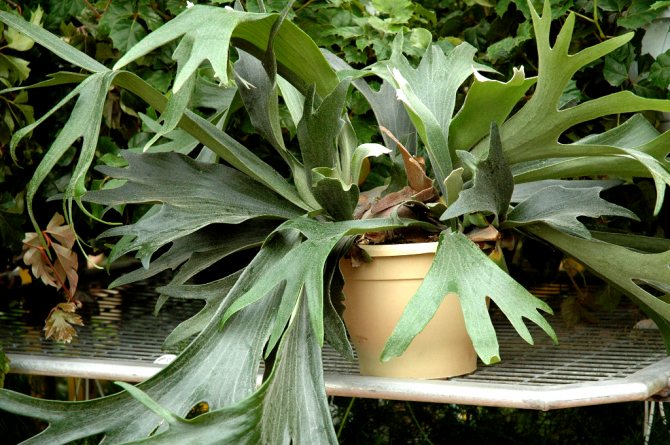

Water this fern species abundantly. But you should not get carried away with this, otherwise the roots will quickly begin to rot. It is best to water it by simply lowering the container with the plant into the prepared, settled water.
Top dressing is carried out approximately once a month in the warm season with fertilizer for decorative flowers or specifically for ferns. In the first case, the concentration of the agent must be made 2 times less than that indicated in the instructions.
This fern species does not bloom.
From about November to April, the plant begins a dormant period. At this time, the temperature can be reduced to 18 degrees, watering is rarely done, only when the soil lump dries up.
The backlight can be omitted even with a short day length.
You can form a bush by splitting off offspring. But pruning and pinching is not recommended.
News:
Family: Centipede (Polypodiaceae).
Homeland: Australia, South India, Africa.
Height: slow.
Shine: diffused, without direct sunlight. The optimal place for placement is windows with a west or east orientation.
Temperature: in the spring-summer period about 20 ° С, in the autumn-winter period - within 15-17 ° С.
Watering: abundant in the spring and summer, after the top layer of the substrate dries up. In winter - moderate, a day or two after the top layer of the substrate dries up. Watered with soft water at room temperature
Air humidity: high. The plant is sensitive to dry air. Measures aimed at increasing air humidity are desirable.
Top dressing: in the spring-summer period, once every 2 weeks, with a semi-concentrated fertilizer for decorative leafy plants.
Rest period: from October to February. The plant is kept in a cool (15-17 ° C) light place. Water in moderation.
Transfer: as needed, about once every three years.
Reproduction: disputes and offspring.
Platycerium, flathorn (Platycerium Desv.), The genus includes up to 12 species of plants of the family of centipedes (Polypodiaceae). Plants are widespread in tropical rain forests in Australia, South India, Africa.
The generic name Platycerium comes from the Greek words platys - flat and keras - horn and is given in the form of wai (leaves), reminiscent of antlers.
Perennial herbaceous plants, epiphytes; branched rhizome (roots develop in the zone of upper leaves; branched roots are also present under the cover of scales). Fronds are spore-bearing and sterile. Spore-bearing - flat, dense-skinned, densely contiguous, some on short petioles, straight, others forked, in the form of horns, drooping, leathery, whole-edged, dichotomously branched midvein, the subsequent ones are located parallel, but form a closed system. Sterile fronds are scaly, sessile, more or less whole, wide, drying quickly (therefore, they turn brown and overlap each other in tiled form). Sterile fronds play an important role in the life of Platyceria. With their lower and lateral edges, sterile fronds are closely pressed to the trunk or branch of the tree on which the plant has settled, while their upper part moves away from the support so that a niche is formed in which humus gradually accumulates, which is formed from the falling leaves of woody plants and from their own dying sterile leaves. With age, the niche increases, and the mass of accumulated humus in the most powerful specimens of the "deer horn" reaches a centner. Under the weight of such giant epiphytes, trees are sometimes uprooted.
Platizeriums are grown in a suspended state or on pieces of bark, stumps, in wooden or plastic baskets, in pots. When buying a plant, it should be borne in mind that flathorns like a relatively cool wintering (15-17 ° C) and high air humidity. In winter, the apartments have central heating, dry air, and the temperature often rises even higher than in the summer months. The most optimal conditions for the growth of the Platycerium can be created in the terrarium.
Views:
Platycerium angolense Welw.ex Bak. Synonym: occurs as Platycerium elephantotis Schweinf. The homeland of the plant is Equatorial Africa. Sterile fronds all-edged, bent back with the upper part. Spore-bearing fronds in the lower part are triangular-wedge-shaped, in the upper part, expanding up to 40 cm wide, not dissected into lobes, hacked along the entire upper edge and dull orange-pubescent. Sporangia are located transversely across the entire width of the leaf. Highly decorative look. Cultivated in warm greenhouses and rooms.
Platycerium large (P. grande (Fee) J. Smith ex G. Prest). The homeland of the plant is Tropical Asia, tropical Australia, the Philippine Islands. Sterile fronds are wide, 45–60 cm wide, deeply forked (do not dry out for a long time); fertile 1.3–2 m long, wedge-shaped, hanging downward, evenly, approximately from the middle of the leaf, forked into belt-like lobes. Highly decorative look. Cultivated in a warm greenhouse and warm rooms.
Platycerium two-forked (P. bifurcatum)or P. alcicorne (Willeraet) Desv... The most common species in indoor culture. The homeland of the plant is Tropical Australia. Sterile fronds are round, 12–20 cm in diameter, convex, lobular along the edges; spore-bearing 50–70 cm long, wedge-shaped narrowed at the base, fan-shaped widened in the upper part and forked into lobes (3-4 cm wide), thick, bluish-green; lobes hanging down. Sporangia throughout the upper part of the lobes are yellow-brown. Highly decorative look. Cultivated in semi-warm greenhouses, florariums, terrariums and rooms.
Hill's Platycerium (P. Hillii Moore). It is similar to the previous species, from which it differs in numerous compact, shallowly dissected straight leaves. Separate segments are shorter and more pointed. Sporangia are collected in oval and rounded masses located near the base of the terminal segments.
| P. angolense (P. elephantotis) | P. grande | P. hillii |
Plant care:
Flathorn prefers diffused light, without direct sunlight. The optimal place for placement is windows with a west or east orientation. On windows with a south orientation, a flat-horn is placed away from the window or diffused light is created with a translucent fabric or paper (gauze, tulle, tracing paper). In winter, they provide the plant with good lighting. Additional lighting can be created using fluorescent lamps, placing them above the plant at a distance of 50-60 cm, for at least 8 hours a day. Drafts should be avoided in autumn and winter.
For successful growth and well-being of the flathorn in the spring-summer period, the optimum temperature is about 20 ° C, at temperatures above 24 ° C, there should be high air humidity, since the plant does not tolerate high temperatures very well. In the autumn-winter period, the optimum temperature is 15-17 ° C. Excessively warm air damages the plant, so it is advisable not to place it near central heating batteries. Drafts should be avoided.
In the spring-summer period, the flathorse is watered abundantly after the top layer of the substrate dries up. In winter, watering is moderate, a day or two after the top layer of the substrate dries. Pour with soft water at room temperature. It is undesirable to excessively overmoisten and overdry the substrate, the soil should always be slightly moist. Over time, sterile fronds can grow so large that they leave no open space for water to enter the pot from above. In this case, it is necessary to use immersion irrigation, while allowing the substrate to be well spilled with moisture.
Flathorse prefers high air humidity. Spraying is useful for him throughout the year. Spray with well-settled or filtered water. With dry indoor air, spraying at least once a day is necessary. To increase moisture, the plant can be placed on a pallet with damp moss, expanded clay or pebbles. In this case, the bottom of the pot should not touch the water. The general humidity in the room or near the plant can be maintained in other ways - for example, by placing the Platycerium in a hanging basket or pots, in the immediate vicinity above an open aquarium. When spraying, use a very fine spray and do not let the moisture remain on the fringes in drops.Do not wipe the plant, because fronds of this fern are covered with the smallest velvet hairs that trap moisture from the air. The most optimal conditions for the growth of the Platycerium can be created in the terrarium.
In the spring-summer period, the flat-horned is fed once every 2 weeks with a semi-concentrated fertilizer for decorative leafy plants. They do not feed in autumn and winter - feeding during this period can lead to a serious disease of the plant.
The fern is transplanted as needed, about once every three years. For transplantation, a shallow wide pot is taken, a drainage layer is placed on the bottom. The flathorse needs a substrate consisting of coarse-fiber peat, sphagnum moss and semi-rotten leaf soil (pH about 6). If the platycerium does not rest on a piece of bark, then it is advisable to add decayed deciduous trees taken from the forest to the soil. It is best to use a commercially available orchid potting mix, it works well for growing Platycerium.
Platizerium can be propagated both by spores and by offspring. Spores form on the underside of the horn-like spore-bearing wai. Growing from spores, however, is a very painstaking and slow process. The offspring growing between overlapping leaves must be carefully separated from the main plant.
Possible difficulties:
Leaves turn yellow, brown spots appear on them. The reason is that the room temperature is too high, above 25 ℃. As the temperature rises, the humidity must also be increased. Irregular or insufficient watering can also be the reason.
The leaves turn yellow, the plant grows poorly - the humidity in the room is too low, the proximity of the heating system.
Leaves are faded, translucent, lethargic - too intense sunlight.
The leaves are pale or dull, the ends turn yellow or brown, the plant does not grow or grows poorly. The reason may be lack of food, too small or too large a pot.
Leaves can turn yellow, brown, curl and fall off, young leaves wither and die at too low room temperatures, from exposure to cold drafts, watering with cold water, when watering with hard or chlorinated water.
Never remove dead sterile leaves.
Damaged: spider mite, scabbard, thrips.
Discuss the article and leave on the forum
Ferns - show photos and admire together!
Fern section on the forum
The following materials were used in the article:
Saakov S.G. Greenhouse and indoor plants and their care. - L .: Nauka, 1985 .-- 621 p.
Indoor floriculture / R. Milevskaya, J. Vies. - Minsk: Book House, 2005. - 608s., Ill.
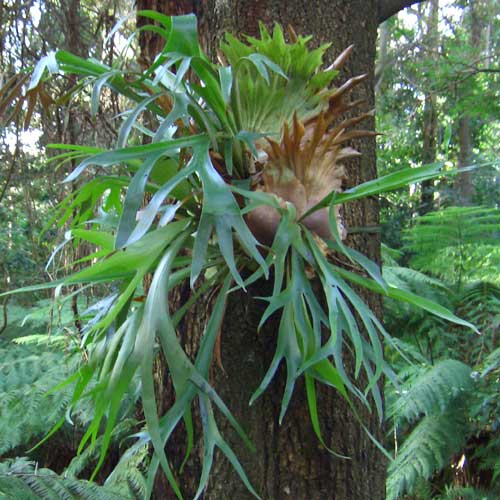

Reproduction methods of the platycerium
- Side shoots. Flathorses release their offspring between overlying leaves. The babies seem to grow between the leaf blades, and it is not at all easy to separate them. During transplantation with a sharp knife, very carefully, trying not to touch the leaves, separate such a process from the mother bush and plant it as a separate plant. Before rooting, carefully monitor the humidity, increase the air humidity to 85-90%.
- Disputes (this method is used only on an industrial scale due to the extremely complex technique of growing young seedlings).
Transplant timing and technology
The procedure is permissible only when the leaf plates are at least as large as the palm of an adult. The root system is small, so there is often no need to transplant.
Sequencing:
- Gently remove the platycerium from the pot, taking care not to damage the roots. The container can be cut with a sharp knife to keep the clod intact.
- Transfer the bush to a horizontal block.
- Cover the rhizome with the substrate on all sides with sphagnum moss.
- Secure the fern with string or thin wire.It is permissible to attach a plastic pot cut from one side with drainage holes in the form of a pocket to the nails.
What is it - platiterium
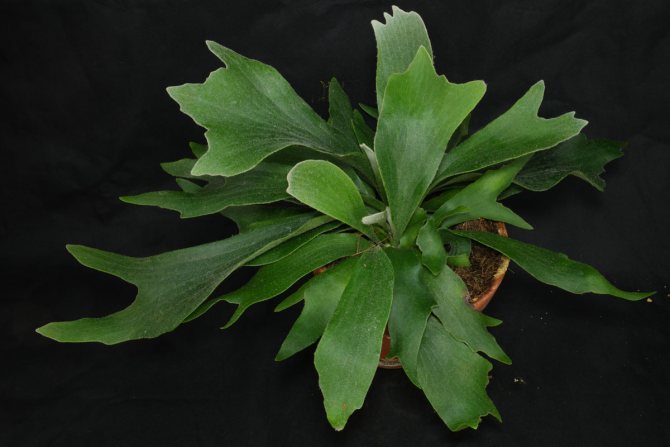

Platitzerium, or plateau, is an extraordinary representative of the most ancient fern family. It is very different from its "relatives" and outwardly resembles deer antlers. The tropics are a natural habitat. You can meet the plant in the forests of Latin America, Australia, Africa. Leads a parasitic lifestyle. Grows high in trees, clinging to their trunk or branches.
The plant has fronds (leaf-like organs) of two main types:
- Spore-bearing fronds are similar to deer antlers. The main function is reproduction. They carry it out late, when the plant reaches the age of 5 years. Another, no less important task of spore-bearing wai is to protect the fern from bright light and retain moisture.
- Vegetative, or sterile fronds, are flat leaves. They help the plant to cling to a tree, branches, shrubs, stones. In the space between the supporting leaves, dead parts of the tree and foliage accumulate. Over time, they rot, becoming a substrate. It is from it that the Platycerium receives the necessary nutrients.
This specimen of ferns has a low growth rate. No more than 3 sheets grow per year. The length of an adult leaf plate can reach 50 cm.
Air humidity
In nature, Platycerium grows in the middle and upper tier of the tropical forest, where the air humidity is not as high as at the soil surface. The dense leathery leaves covered with the smallest scales contribute to the successful existence in these conditions. Therefore, Platyceria are less likely than other ferns to suffer from dry air
our apartments. Although, of course, the humidity of the room air, especially when the heating is operating, is far from comfortable values, and it must be increased by all available means.
Why does the plant get sick
Due to excessive waterlogging, dark spots formed by fungi appear on the leaves of the flower. Of the pests, Platycerium also affects the spider mite, scale insects, thrips and because of this, the foliage begins to thin and fall off. For rescue, treatment with special chemical insecticides is necessary, and better with modern bio-preparations, for example, Aktellikom or Fitoveram.
With an excess of light, the leaves turn pale and wither. Excessively dry air causes the ends of the wai to dry out, a cramped pot stops fern growth, frequent drafts and coolness in the house cause foliage to fall off and curl. In this case, it is necessary to adjust the care.

